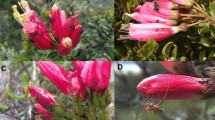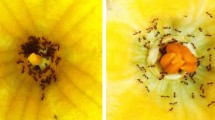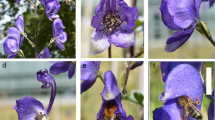Abstract
The phenomenon of ant-guarding on Acacia trees is probably the best known case of a mutualism between plants and animals, the ants conferring biotic defence against herbivores and perhaps against encroaching vegetation1,2,3. However, as with many defence mutualisms, sometimes the interests of the plant and its defender conflict: for example, when they are in flower the Acacia trees require the presence and service of other insects to effect cross-pollination. How is pollinator access achieved in the face of aggressive ant-guards? Here we report that ants are deterred from young flowers at the crucial stage of dehiscence, allowing bees and other pollinators to visit and transfer pollen. This deterrence appears to be a response to a volatile chemical signal from young flowers, perhaps from the pollen itself. Ants patrol the young (undehisced) buds, and also return to the flowers after dehiscence, protecting the fertilized ovules and developing seeds. The outcome is a directly improved seed-set in the presence of ants (rather than an indirect extra reproductive resource allocation due to decreased defoliation4,5,6).
This is a preview of subscription content, access via your institution
Access options
Subscribe to this journal
Receive 51 print issues and online access
$199.00 per year
only $3.90 per issue
Buy this article
- Purchase on Springer Link
- Instant access to full article PDF
Prices may be subject to local taxes which are calculated during checkout



Similar content being viewed by others
References
Janzen, D. H. Coevolution of mutualism between ants and Acacia in Central America. Evolution 20, 249–275 (1966).
Hocking, B. Insect associations with the swollen-thorn acacias. Trans. R. Ent. Soc. Lond. 122, 211–255.
Knox, R. B., Marginson, R., Kenrick, J. & Beattie, A. J. in Insects and the Plant Surface (eds Juniper, B. E. & Southwood, T. R. E.) 295–307 (Arnold, London, (1986)).
Del-Claro, K., Berto, V. & Reu, W. Effect of herbivore deterrence by ants on the fruit set of an extrafloral nectary plant Qualea multiflora (Vochysiaceae). J. Trop. Ecol. 12, 887–792 (1996).
Niesenbaum, R. A. Linking herbivory and pollination: defoliation and selective fruit abortion in Lindera benzoin. Ecology 77, 2324–2331 (1996).
Koptur, S. in Insect–Plant Interactions (ed. Bernays, E.) 81–129 (CRC Press, Boca Raton, (1992)).
Ross, J. H. An analysis of the African Acacia species: their distribution, possible origins and relationships. Bothalia 13, 389–413 (1981).
Young, T. P., Stubblefield, C. H. & Isbell, L. A. Ants on swollen thorn Acacias: species coexistence in a simple system. Oecologia 109, 98–107 (1997).
Stone, G. N., Willmer, P. G. & Nee, S. Daily partitioning of pollinators in an African Acacia community. Proc. R. Soc. Lond. B 263, 1389–1393 (1996).
Tybirk, K. Pollination, breeding system and seed abortion in some African acacias. Bot. J. Linn. Soc. 112, 107–137 (1993).
Feinsinger, P. & Swarm, L. A. How common are ant-repellent nectars? Biotropica 10, 238–139 (1978).
Prys-Jones, O. E. & Willmer, P. G. The biology of alkaline nectar in the Purple Toothwort (Lathrea clandestina): ground level defence. Biol. J. Linn. Soc. 45, 373–388 (1992).
Acknowledgements
We thank D. Mafunde at Mkomazi Research Station for expert field assistance; T. Morgan and N. McWilliam for invaluable logistic back-up; and M. Ritchie and J. Graves for statistical advice. We thank the Royal Geographical Society, the Darwin Initiative and the British Council for financial support, as part of the Mkomazi Ecological Research Programme, and the Department of Wildlife of the Tanzanian Government.
Author information
Authors and Affiliations
Corresponding author
Rights and permissions
About this article
Cite this article
Willmer, P., Stone, G. How aggressive ant-guards assist seed-set in Acacia flowers. Nature 388, 165–167 (1997). https://doi.org/10.1038/40610
Received:
Accepted:
Issue Date:
DOI: https://doi.org/10.1038/40610
This article is cited by
-
Ant pollination of Syzygium occidentale, an endemic tree species of tropical rain forests of the Western Ghats, India
Arthropod-Plant Interactions (2018)
-
Ant-Repelling Pollinators of the Myrmecophytic Macaranga winkleri (Euphorbiaceae)
Evolutionary Biology (2016)
-
The reproductive biology of the myrmecophyte, Hirtella physophora, and the limitation of negative interactions between pollinators and ants
Arthropod-Plant Interactions (2015)
-
Diversity and evolution of pollinator rewards and protection by Macaranga (Euphorbiaceae) bracteoles
Evolutionary Ecology (2015)
-
Multitasking in a plant–ant interaction: how does Acacia myrtifolia manage both ants and pollinators?
Oecologia (2015)
Comments
By submitting a comment you agree to abide by our Terms and Community Guidelines. If you find something abusive or that does not comply with our terms or guidelines please flag it as inappropriate.



